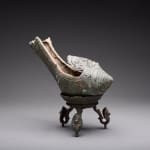Ritual Conch with Pedestal, 12th Century CE - 13th Century CE
Bronze
21.9 x 17.8 cm
8 5/8 x 7 1/8 in
8 5/8 x 7 1/8 in
FZ.250
Further images
Centuries ago, a brilliant civilization flourished in the valleys and plains of what is now Cambodia. The Khmer culture created a remarkable artistic legacy, boldly expressive in form yet delicate...
Centuries ago, a brilliant civilization flourished in the valleys and plains of what is now Cambodia. The Khmer culture created a remarkable artistic legacy, boldly expressive in form yet delicate in its sensibility. The most famous Khmer monument is the vast temple complex at Angkor Wat, but works in bronze are equally remarkable in their power. Created in imitation of a seashell, this ornate bronze conch may have served as a ceremonial dipper, holding holy water used during ritual ceremonies. However, judging from the refinement of the mouthpiece, it is more likely that this conch was once a wind instrument that produced the sacred sound inherent in all things, “om.” The sound would have been produced in the chamber formed by a separately inserted crosspiece. Regardless of its function, this conch skillfully combines natural forms with elaborate decoration. The pedestal base on which it rests is adorned with images of Nagas, water deities also known as guardians of treasure. Graceful and powerful at once, this lovely conch is a treasure from a lost civilization.









